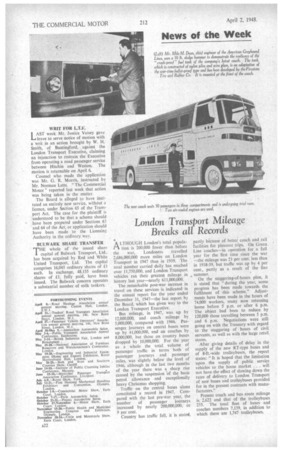London Transport Mileage Breaks all Records
Page 24

If you've noticed an error in this article please click here to report it so we can fix it.
A LTHOUGH London's total popular-k lion is 200,000 fewer than before
the war, Londoners travelled 2,686,000,000 more miles on London Transport in 1947 than in 1939. The total number carried daily has reached over 11,750,000, and London Transport vehicles ran their greatest mileage in history last year—nearly 611,000,000.
The remarkable post-war increase in travel on these services is indicated in the annual report for the year ended December 31, 1947—the last report by the Board, which has given way to the London Transport Executive.
Bus mileage, in 1947, was up by 12,000,000, and coach mileage by 5,000,000, compared with 1946. Passenger journeys on central buses were up by 41,000,000, and on coaches by 8,000.000, but those on country buses dropped by 10.000,000. For the year as a whole the total volume of passenger traffic in terms both of passenger journeys and passenger miles, was slightly below the level of 1946, although in the last two months of the year there was a sharp rise caused by the suspension of the basic petrol allowance and exceptionally heavy Christmas shopping.
Traffic on the central buses alone constituted a record in 1947. Compared with the last pre-war year, the number of passenger journeys increased by nearly 200,000,000, or 9 per cent. Country bus traffic fell, it is stated, partly bicause of better coach and rail facilities for pleasure trips. On Green Line coaches—in operation for a full year for the first time since the war —the mileage was 21 per cent, less than in 1938-39, but traffic was up by 4 per cent., partly as a result of the fine summer.
On the staggering-of-hours plan, it is stated that during the year, some progress has been made towards the fulfilment of this scheme." Adjustments have been made in the hours of 74,000 workers, many now returning home before 5' p.m. or after 6 p.m. The object had been to reduce by 120,000 those travelling between 5 p.m. and 6 p.m. Negotiations were still going on with the Treasury with regard to the staggering of hours of civil servants, as well as with the large retail stores.
After giving details of delay in the supply of the new RT-type buses and of 8-ft.-wide trolleybuses, the report states: " It is hoped that the limitation upon the supply of public service vehicles to the home market . . . will not have the effect of slowing down the rates of delivery to London Transport of new buses and trolleybuses provided for in the present contracts with manufacturers."
Present coach and bus route mileage is, 2,622 and that of the trolleybuses 255. The total fleet of buses and coaches numbers 7,139, in addition to which there are 1,747 trolleybuses.












































































